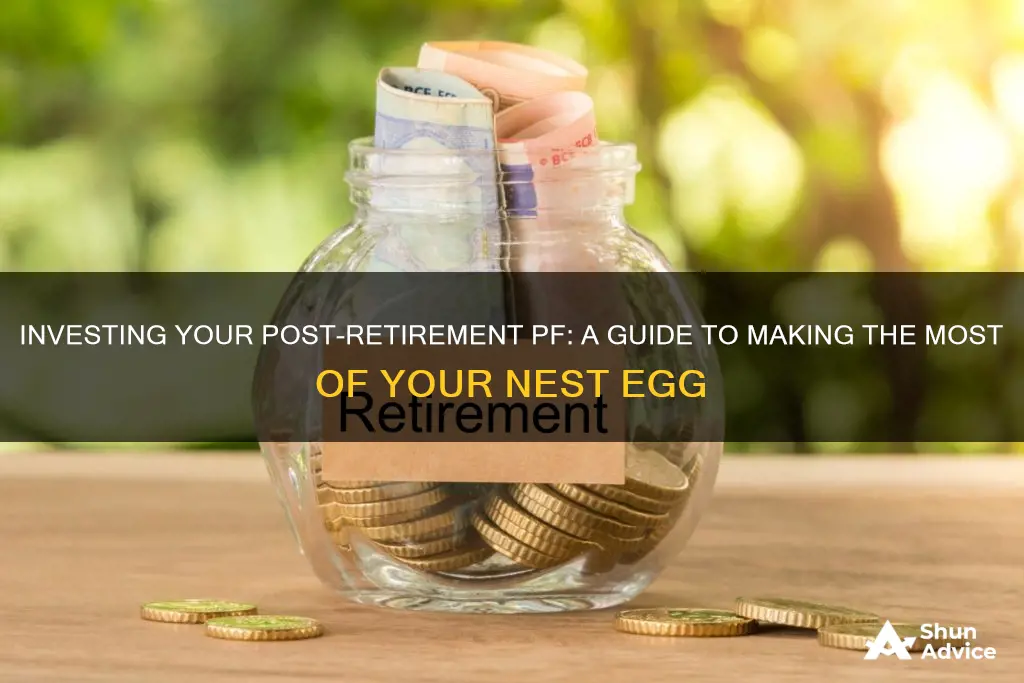
Investing your provident fund (PF) amount after retirement is an important consideration to ensure financial stability. While the PF account can provide a substantial corpus, it may not be sufficient to cover all retirement expenses, especially with inflation. Therefore, investing your PF amount wisely can help generate wealth and income for a comfortable retirement. This involves considering various investment options, such as fixed deposits, shares, mutual funds, real estate, and retirement schemes like the Senior Citizens' Savings Scheme (SCSS). Additionally, managing financial liabilities, seeking low to moderate-risk products, ensuring regular cash flow, and maintaining an emergency fund are crucial aspects of retirement planning.
What You'll Learn

Invest in fixed deposits
Fixed deposits are a great option for retired individuals who want to ensure the stability of their investments. They are a safe, flexible, and popular investment option in India. FDs are considered a good investment option for people with a low-risk appetite who want to invest but cannot stomach high risk.
FDs are a type of investment where you put money into an account at a financial institution for a fixed period at a predetermined rate of interest. The rate of interest varies from one financial institution to another, although it is usually higher than the interest offered on savings accounts. The interest offered depends on the tenure or maturity period of the FD. A 7-day fixed deposit will carry a lower annual interest rate compared to a one-year FD. This is to compensate for the time-risk of money. Simply put, a rupee today is more valuable than a year from now because inflation pushes up prices over time.
FDs are available for different periods, ranging from very short-term tenures of 7-14 days to long tenures of 10 years. The interest offered depends on the duration of the investment and the financial institution offering the FD. The minimum amount of investment in an FD varies from bank to bank, with some plans allowing investments as low as Rs. 500.
There are two types of FDs: cumulative and non-cumulative. Cumulative FDs pay you the interest and the principal at maturity, with the interest being reinvested every year. This means that you will not be eligible to receive regular interest payouts but will instead receive a lump sum at the end of the FD tenure. Non-cumulative FDs will pay you interest at fixed intervals, which you can choose to be monthly, quarterly, half-yearly, or annually. This will give you a regular stream of income, but you will lose out on earning interest on the reinvested interest.
FDs are a good option for retired individuals as they provide assured returns on your principal amount, with no risk of being affected by market forces. They are also a good way to balance the risk in your overall portfolio. Even for those with a medium-to-high-risk appetite, investing a portion of your funds in fixed deposits can balance out the risk from market-linked instruments like equity or mutual funds.
Additionally, FDs offer flexibility in terms of tenure, with options ranging from very short-term to long-term tenures. You can also choose to reinvest the interest or receive interest amounts periodically in your bank account. FDs also have a low minimum investment amount, making them accessible to those who want to start investing with a small amount.
In conclusion, investing in fixed deposits is a safe and flexible option for retired individuals looking to grow their savings while minimising risk. With assured returns and the ability to choose the tenure and interest payment frequency, FDs can be a stable and reliable investment option for retirement planning.
Altcoin Investment: Best Picks
You may want to see also

Invest in shares and mutual funds
Investing in shares and mutual funds can be a great way to grow your EPF savings and generate wealth. Here are some things to keep in mind:
Mutual Funds
Mutual funds are a popular investment option, especially for retirement accounts. They are a pool of money from many investors, managed by a financial services company. The fund manager selects a mix of stocks, bonds, and other assets to invest in, aiming to provide diversification and reduce risk. Mutual funds can be a good choice if you want professional investment expertise and the benefits of investing in a wide range of assets. They are also highly liquid, allowing you to exit your investment at any time.
When choosing a mutual fund, consider the fund's performance over different time periods and its expense ratios. You can also look for funds with a good rating from independent agencies like Morningstar. Additionally, consider your own risk tolerance—while mutual funds are generally considered safer than investing directly in individual stocks, some funds are more aggressive, while others are more conservative.
Shares
Shares, or stocks, can offer potentially higher returns but come with higher risk. If you're considering investing in individual stocks, it's important to seek expert guidance, especially if you're nearing retirement. Stocks can be a good way to beat inflation, but they are subject to market volatility.
Retirement Income Funds
Retirement income funds are a type of mutual fund designed specifically for retirees. They aim to provide a steady income with moderate gains and a strong focus on dividends and interest income. These funds typically invest in a mix of stocks and fixed income, with a larger portion in fixed income to provide stability. Some popular examples include:
- American Funds Tax-Aware Conservative Growth and Income Portfolio (TAIFX)
- Schwab Balanced Fund (SWOBX)
- Vanguard Wellington Fund (VWELX)
- Dodge and Cox Income Fund (DODIX)
- T. Rowe Price Dividend Growth Fund (PRDGX)
Things to Keep in Mind
- Risk and Diversification: Investing in shares and mutual funds can be risky, so it's important to balance these investments with low-risk options like fixed deposits. Diversification is key—spread your investments across different asset classes, sectors, and industries.
- Tax Efficiency: Consider the tax implications of your investments. For example, investing in a traditional 401(k) or IRA can reduce your taxable income for the year, while a Roth IRA is taxed upfront but allows tax-free withdrawals during retirement.
- Fees and Expenses: Mutual funds and other investment funds typically charge expense ratios and other fees. These can eat into your returns over time, so be sure to consider them when making investment decisions.
- Seek Expert Advice: Consult a financial advisor or planner who can provide personalized guidance based on your specific financial situation and goals.
NIO Stock: Buy or Bye?
You may want to see also

Build a safety net using SCSS
When it comes to investing your Provident Fund (PF) savings for retirement, there are several options to consider. One option is to build a safety net using the Senior Citizens Savings Scheme (SCSS). Here are some key things to know about SCSS:
SCSS is a customised investment option for senior citizens, offering an interest rate of up to 7.4%. You can invest for a period of 5 years and then renew for another 3 years. The investment amount can range from Rs. 1,000 to Rs. 15 lakh.
Benefits of SCSS
SCSS provides a stable investment option that is not influenced by market forces and is backed by the government. It offers attractive returns of more than 8%, helping you build a significant maturity amount. Additionally, it enables you to avail tax benefits while you're still earning. You can choose to invest in a single account or a joint account.
How to Invest in SCSS
To invest in SCSS, you can open an account with a post office or a bank. You will need to provide proof of your age and address, as well as a passport-sized photograph. The minimum investment amount is Rs. 1,000, and you can choose to invest for a period of 5 years, with the option to renew for another 3 years.
Comparing SCSS with Other Options
When considering different investment options for your PF amount, it's important to compare the benefits and risks of each. SCSS offers a stable and secure option with guaranteed returns, making it ideal for risk-averse investors. However, the returns may be lower compared to other options like mutual funds or equity investments. It's essential to assess your financial goals, risk tolerance, and time horizon before deciding on the best investment option for your retirement.
Other Investment Options
In addition to SCSS, you can explore other investment avenues to diversify your portfolio. These include fixed deposits, mutual funds, equity, real estate, and the National Pension System (NPS). Each option has its own set of advantages and risks, so it's crucial to understand your financial needs and seek expert advice before making investment decisions.
Young and Investing: Strategies for an Early Retirement
You may want to see also

Use it to invest in real estate
Real estate can be a great investment option for your PF money after retirement. It offers a high rate of return and can be used to hedge against inflation. Here are some things to keep in mind if you're considering investing your PF amount in real estate:
Rental Income
One of the main advantages of investing in real estate is the potential for rental income. When you own rental units, you can enjoy a steady stream of income from your tenants, which can help cover your property expenses and yield profits. This predictable cash flow makes real estate an attractive choice for retirees seeking a consistent income stream.
Long-Term Appreciation
Historically, real estate has shown a tendency to increase in value over time. While short-term fluctuations can occur, the value of well-located properties tends to rise over the years. This provides investors with the possibility of substantial capital gains when they decide to sell.
Tax Advantages
Real estate investments also come with tax benefits. Many countries offer tax deductions for expenses related to owning and maintaining investment properties, such as mortgage interest, property taxes, and depreciation. These deductions can significantly reduce your overall tax liability and increase your net earnings.
Location and Market Conditions
When investing in real estate, it's important to consider the location and market conditions. Properties in high-demand areas with strong rental demand tend to generate more income. Look for areas with good job opportunities, schools, and amenities. Additionally, keep an eye on market fluctuations. In some periods, property values may appreciate rapidly, increasing your potential earnings.
Financing and Costs
If you don't have enough capital to pay for the property in cash, you'll need to secure financing. Typically, a down payment of around 20% to 30% of the purchase price is required for investment properties. Additionally, don't overlook the costs associated with the transaction, such as commissions, closing costs, and marketing expenses.
Property Management
Consider whether you'll manage the property yourself or hire a property management company. Management fees can range from 8% to 12% of the rent you collect. A reliable property manager can help maximize your returns by keeping vacancies filled and addressing maintenance issues promptly.
Potential Problems
Real estate investments also come with certain risks and challenges. These include market volatility, unexpected repairs, and vacancies. Financing can also be a hurdle, as securing loans for investment properties may involve complex processes and high-interest rates. Additionally, real estate investments are relatively illiquid, so selling a property may take time and incur transaction costs.
In conclusion, investing your PF amount in real estate after retirement can provide a high rate of return and help you hedge against inflation. However, it's important to carefully consider the potential risks and challenges and to seek advice from financial professionals to make informed decisions.
Ebooks: Eco-Friendly, Accessible, Affordable
You may want to see also

Settle your financial liabilities
Settling your financial liabilities is an important step in planning for retirement. Here are some strategies to consider:
Understand Your Liabilities and Seek Professional Help
It is important to have a clear understanding of your financial liabilities, including any debts, loans, or outstanding payments you owe. Consider seeking professional help from a financial advisor or accountant to assess your liabilities and create a plan to address them.
Prioritize Repayment of High-Interest Debt
Focus on repaying any high-interest debt, such as credit card debt, as soon as possible. These types of debt can accumulate quickly and become a significant burden if not managed effectively.
Negotiate with Creditors
If you are struggling to repay your debts, consider negotiating with your creditors. You may be able to work out a repayment plan or settle your debt for a lower amount. However, be cautious and prioritize payments to avoid further financial strain.
Protect Your Retirement Savings from Creditors
In most cases, funds in qualified retirement accounts, such as 401(k) plans, are generally protected from private creditors. These funds are typically off-limits to commercial creditors and can only be accessed by you. However, there are exceptions, such as federal tax liens, alimony, or child support payments, where your retirement savings may be vulnerable.
Consider Consolidating Your Debt
Debt consolidation can be a useful strategy to simplify your financial liabilities. You may be able to consolidate multiple debts into a single, lower-interest loan, which can make repayment more manageable. However, be sure to carefully evaluate the terms and conditions before consolidating.
Create a Budget and Stick to It
Creating a budget and sticking to it is crucial for managing your finances effectively. Track your income and expenses, and allocate your funds efficiently to ensure you can meet your financial obligations while also saving for retirement.
Remember, settling your financial liabilities is an important step towards achieving financial security in retirement. It is always best to seek professional advice to ensure you are making informed decisions about your money.
Dubai's Investment Trends
You may want to see also
Frequently asked questions
It is advisable to withdraw the PF balance and invest it based on your goals and needs. If you choose not to withdraw, the interest earned on the balance will be subject to tax.
Some meaningful ways to invest your PF money include fixed deposits, shares and mutual funds, real estate, and the Senior Citizens Savings Scheme (SCSS).
Fixed deposits offer assured returns on your principal amount, high-interest rates with stability, and flexible tenor. They are also not affected by market forces, so your principal amount remains intact.
While investing in stocks can help beat inflation, it is a risky avenue and seeking expert guidance is necessary. Other options include the National Pension System (NPS), which offers tax deductions and fixed monthly payouts, and mutual funds, which offer diversification and are managed by expert fund managers.
You may choose various options for regular interest payment or dividend payouts, such as monthly or quarterly interest payment options in your Post Office Savings. You can also opt for a dividend option or a Systematic Withdrawal Plan (SWP) in your mutual fund investments.







